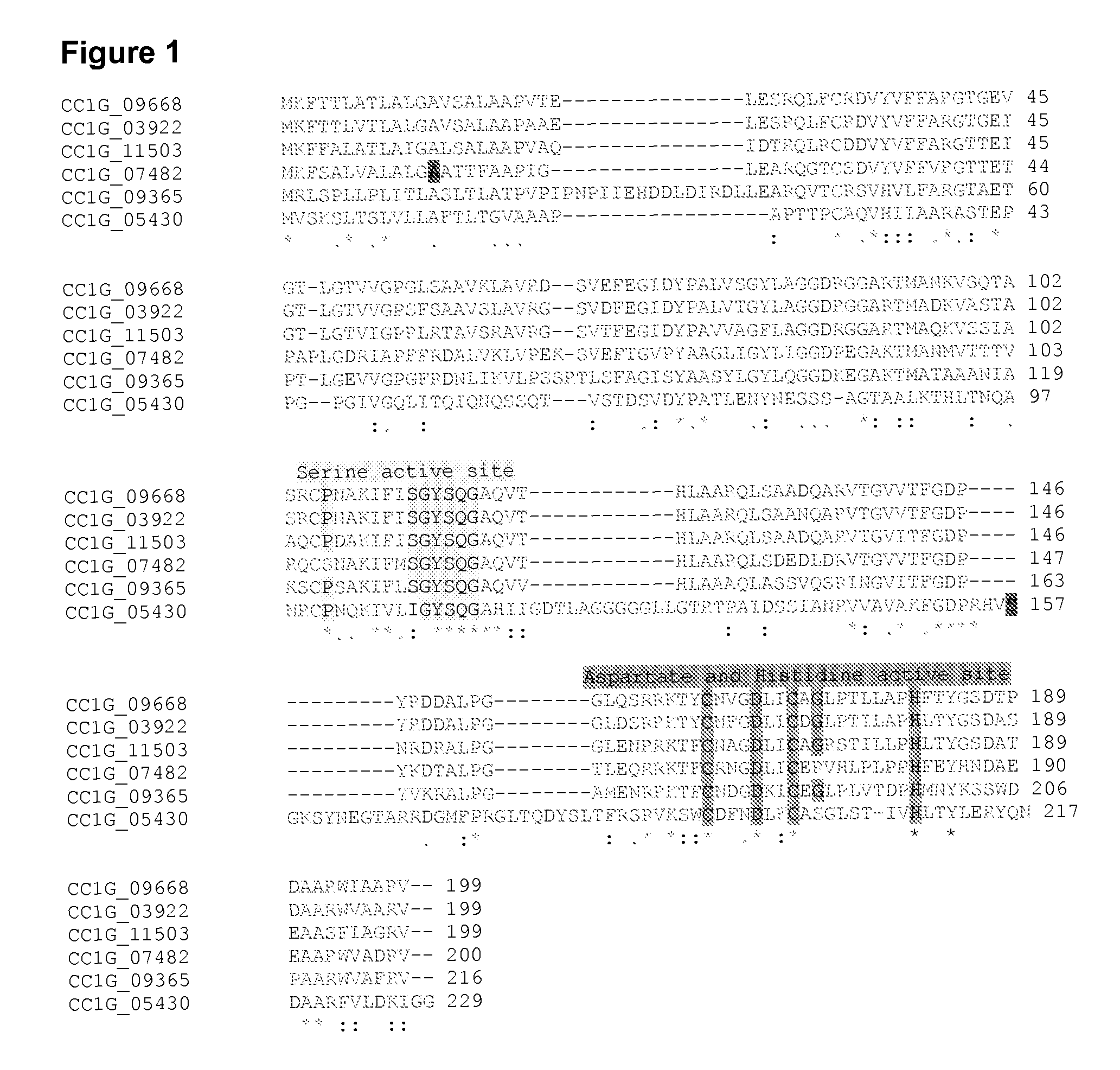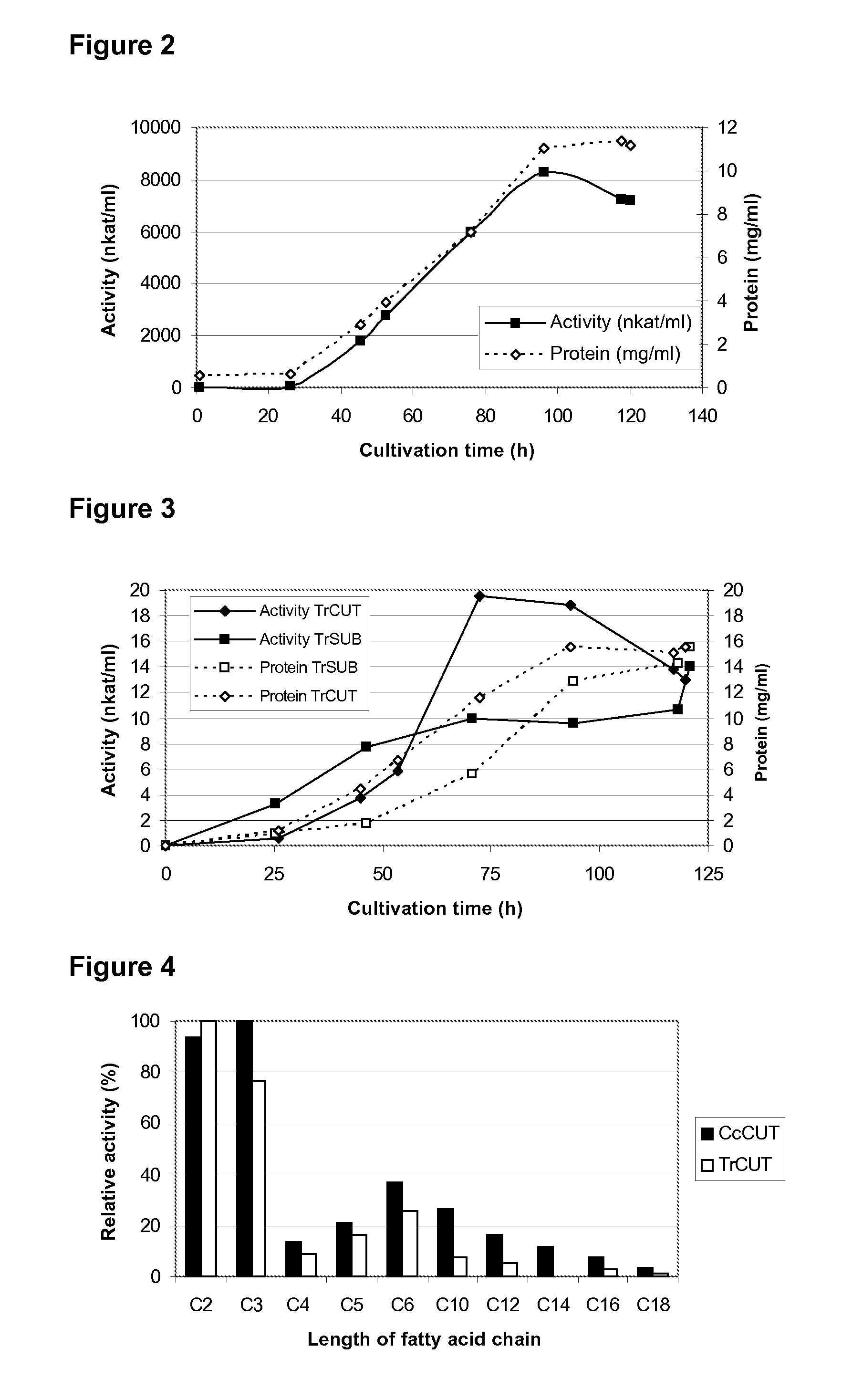Esterases and their use
a technology sterases, applied in the field of sterases, can solve the problems of limited set of lipid modification enzymes, commercially available, and affect the industrial processing of plant materials
- Summary
- Abstract
- Description
- Claims
- Application Information
AI Technical Summary
Benefits of technology
Problems solved by technology
Method used
Image
Examples
example 1
Measurement of Polyesterase Activities
Methods to Model Suberin Degradation
[0041]The degradation of the aliphatic layer of suberin was imitated by model substrates, i.e. naphthol derivatives differing both in the bulkiness of the chromophore (1-naphthyl, 2-naphthyl, Naphthol AS, Naphthol AS-D) and the length of the ester-bonded carbon chain. Substrate solutions of naphthol derivatives (0.5-1 mM) were prepared in 1% acetone and 1% TRITON™ X-100 (non-ionic octylphenol ethoxylate surfactant) in 50 mM Na-citrate (pH 5) or 50 mM NaP (pH 8). The reaction mixture containing 170 μl substrate solution and 10 μl enzyme sample was incubated at 40° C. for 20 minutes. After incubation, 20 μl of 1% Fast Blue BB salt dye was added, and absorbance (1NA substrates—450 nm, 2NA substrates—510 nm, NAS substrates—595 nm, NASD substrates—595 nm) was measured after additional incubation of 10 min. The enzyme activities were determined by reference to a standard curve prepared from various amounts of 1NA, 2...
example 2
Screening of Polyesterolytic Activities
[0046]Altogether 55 microorganisms, mostly filamentous fungi, were screened for their ability to produce suberin modifying enzymes in suberin-induced conditions. The screening was based on the enzymatic assays of culture supernatants (hydrolysis of naphtol substrates and a fluorescently labelled aromatic compound and radiolabelled suberin, as described in Example 1) and GC / MS analysis of separated solids, whereby increased amounts of long fatty acids, such as hydroxy fatty acids and diols, confirmed that a microorganism was able to degrade suberin during its growth. Coprinus cinereus and Trichoderma reesei were found to be potential producers of cutin / suberin degrading enzymes.
example 3
Genome Analysis of Coprinus cinereus for Polyesterase Encoding Genes
[0047]Coprinus cinereus was found to be able to produce polyesterases having activity on natural polyesters such as cutin and suberin (Example 2). The published genome of Coprinus cinereus (www.broad.mit.edu / annotation / genome / coprinus_cinereus / Home.html) was exploited for similarity searches based on known polyesterases (cutinases and suberinases), and six different cutinase-like genes were found. Protein similarities were analysed with Clustal w multiple alignment program. Five of the genes (CC1G—09668.1, CC1G—03922.1, CC1G—11503.1, CC1G—07482.1, and CC1G—09365.1) showed high sequence homology to cutinases and one (CC1G—05430.1) shared higher homology with acetyl xylan esterases (AXE) having e.g. a sequence identity of 30% with Trichoderma reesei AXE1. The results are shown in FIG. 1, where the serine active site and the aspartate and histidine active sites of the cutinases are indicated. Said genes and correspondi...
PUM
| Property | Measurement | Unit |
|---|---|---|
| pH | aaaaa | aaaaa |
| pH | aaaaa | aaaaa |
| pH | aaaaa | aaaaa |
Abstract
Description
Claims
Application Information
 Login to View More
Login to View More - R&D
- Intellectual Property
- Life Sciences
- Materials
- Tech Scout
- Unparalleled Data Quality
- Higher Quality Content
- 60% Fewer Hallucinations
Browse by: Latest US Patents, China's latest patents, Technical Efficacy Thesaurus, Application Domain, Technology Topic, Popular Technical Reports.
© 2025 PatSnap. All rights reserved.Legal|Privacy policy|Modern Slavery Act Transparency Statement|Sitemap|About US| Contact US: help@patsnap.com


